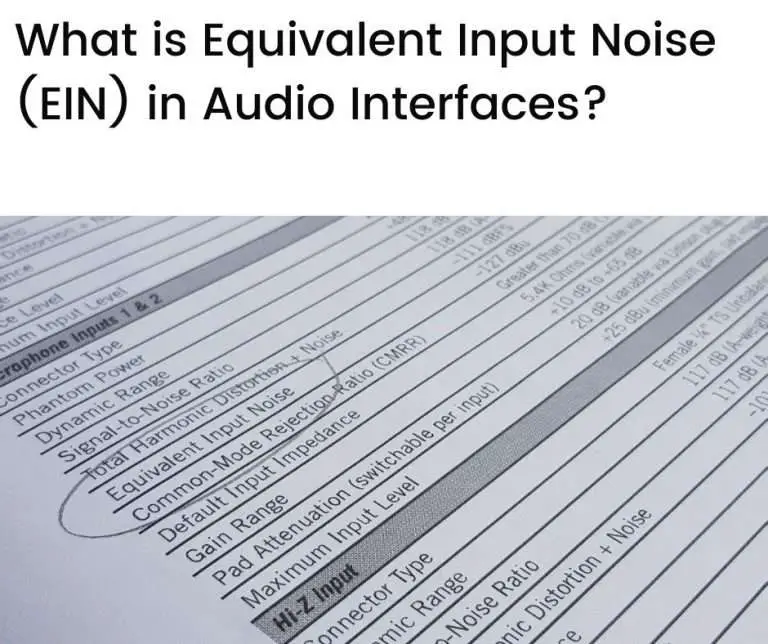dBFS, or dB relative to full scale, is a metric used in digital audio systems. It’s derived from dB, which compares signal levels, and measures how far a signal’s amplitude is below its peak amplitude. dBFS has practical benefits in digital production environments, allowing calibration to a maximum reference point and helping to ensure sufficient headroom during production.
In this article we’ll look at:
- What is dBFS?
- What is dB in audio?
- How is dBFS calculated?
- Why dBFS is negative and how it’s used in digital audio production
- What’s the difference between 0 dB and 0 dBFS?
- Conclusion
What is dBFS?
dBFS is an abbreviation for decibels relative to full scale. It’s a unit of measurement used in digital audio systems.
dBFS is expressed as a negative number relative to the maximum level available in a digital system. This reference to a maximum level conveys the full scale of levels available to audio signals in a digital audio system.
dBFS is derived from decibels (dB), another commonly used measure for comparing audio signals and other values. dB is widely used for measuring sound and audio metrics, including dB SPL, dBA, dB HL, dBu, and dBV.
dBFS, however, is expressed differently from dB, and dB is not limited to digital systems.
To understand more about dBFS’s role in digital audio, let’s take a closer look at dB and how it’s calculated, how dBFS is derived from dB, and how dBFS is used in digital audio systems.
What is dB in audio?
In the world of audio, dB is an abbreviation for decibels and is a term that you’ll hear often—but what exactly is it?
Decibels measure signal amplitude ratios
Decibels—dB—is simply a measure of the ratio between two values.
When applied to audio signals, the values that we often wish to compare are the amplitudes between two audio signals.
In this case, decibels are defined as:
dB = 20log10(A1/A2)
Where, A1 and A2 are the amplitudes of the signals that you’re comparing.
So, if a signal (signal 1) has an amplitude of, say, 100 times the amplitude of a second signal (signal 2), then we can compare their amplitudes using dB as follows:
Signal 1 vs signal 2 (dB) = 20log10(100) = 40 dB
The origins of dB come from the days of early telephony—the name “dB” is related to the term “bel”, named after Alexander Graham Bell, a pioneer of modern telephony.
Technically, 1 dB = 1/10th of a bel.
Why are decibels logarithmic?
You’ll notice the formula for dB includes a logarithmic calculation.
Logarithms are a convenient way of expressing multiples between numbers. But why do we use them in audio signal dB calculations?
The reason lies in how humans perceive the loudness of sounds.
Studies have shown that sounds are considered to be twice as loud with each 10 dB increase in its sound pressure level. This translates to a 20 dB increase in audio signal amplitude levels.
But, a 20 dB increase in signal amplitude is just another way of describing a 10-fold increase in signal amplitude—we can see this from the formula for dB:
20 dB increase = 20log10(10) = 20 x 1 = 20 dB
So, given the nature of human hearing, sounds get progressively louder in a “multiplying”—or logarithmic—manner. Hence, using a logarithmic scale is a convenient way to express this.
How is dBFS calculated?
dBFS is calculated in the same way as dB, i.e., using the same formula.
dBFS is expressed differently, however, from dB.
Like dB, dBFS measures the ratio between two signal levels. Hence, both dB and dBFS are dimensionless metrics that measure the relative difference between two signal levels.
dBFS is expressed relative to a maximum signal level
If we are comparing two signal amplitudes with one being, say, ten times larger than the other, we know that their difference would be 20 dB.
When using dBFS, however, all signals are compared to the maximum (peak) level that’s possible for the signal.
We can think of the maximum, or peak, level of a signal to be the level at which clipping starts to occur. Clipping is the type of distortion that occurs when a signal exceeds its maximum threshold.
With dBFS, rather than comparing two signal levels directly, we would express each signal’s amplitude relative to the maximum that’s possible for the signal (or the maximum for all signals in a particular digital system).
So, if we modify our example and consider a signal that has an amplitude at a level that’s 1/10th of the maximum that’s possible for the signal, we would express that signal’s amplitude as -20 dB.
dBFS calculation
We can adjust the formula for dB to cater to the way in which dBFS is expressed:
dBFS = 20log10(A/Max)
Where A is the amplitude of the signal that you’re measuring and Max is the maximum (peak) amplitude that’s possible for that signal.
In our modified example, if the signal’s amplitude is, say, 1, and the maximum amplitude that’s possible for the signal (before clipping) is 10, then we can measure the dBFS for the signal as:
dBFS = 20log10(1/10) = -20 dBFS
Another way of saying this is that the signal in our example is at a level that’s 20 dB below its clipping point (maximum).
Illustrative dBFS scale
From our example, we can see that for every 10-fold reduction in a signal’s amplitude relative to its maximum, the dBFS decreases by 20 dB.
The table below illustrates how dBFS changes with the reduction in a signal’s amplitude relative to its maximum (peak) level.
| Relative Signal Amplitude | dBFS |
|---|---|
| 10,000 (Maximum) | 0 |
| 1,000 | -20 |
| 100 | -40 |
| 10 | -60 |
| 1 | -80 |
| 0.1 | -100 |
Why dBFS is negative and how it’s used in digital audio production
As we know, dBFS is expressed relative to a signal’s maximum level.
As shown in the above table, the dBFS of a signal when it’s at its maximum is 0. The signal level can only decrease from its maximum, hence all other dBFS measurements for the signal will be negative.
The reason why dBFS is expressed in this way has to do with how it’s used in digital audio production environments—there are two primary benefits:
- Common calibration— According to the Alabama Broadcasters Association, in a digital audio production environment it’s helpful to calibrate all equipment in the workflow relative to a common maximum level (i.e., 0 dBFS).
- Ensuring sufficient headroom— A common maximum calibration also helps to ensure sufficient headroom for the production process. The headroom is a margin below the maximum (e.g., -6 dBFS) that’s maintained to allow sufficient dynamic scope during the recording, mixing, and mastering stages of production. Having sufficient headroom leads to better-sounding results.
So, negative dBFS is a convention that’s related to the way dBFS is used in digital audio production environments. It has evolved from the practicalities of effectively managing audio signals in these environments.
What’s the difference between 0 dB and 0 dBFS?
By now, the differences between dB and dBFS should be clear—both measure ratios, but dBFS is expressed relative to a maximum level.
Hence, 0 dB describes the situation when two audio signals have exactly the same amplitude (whatever the level of that amplitude).
We can see this from the formula for dB. Consider two signals that have the same amplitudes, and consider three examples where their amplitude is, say, 1, 30, and 455—this is illustrated in the table below.
| db 0 Illustration | Signal 1 Amplitude (A1) | Signal 2 Amplitude (A2) | dB = 20log10(A1/A2) |
|---|---|---|---|
| Example 1 | 1 | 1 | 20log10(1/1) = 0 |
| Example 2 | 30 | 30 | 20log10(30/30) = 0 |
| Example 3 | 455 | 455 | 20log10(455/455) = 0 |
In each case, since both signals have the same amplitude (i.e., the ratio of their amplitudes is always 1), the dB of one signal relative to the other is 0.
0 dBFS, however, describes a situation when a signal is at its maximum amplitude level (whatever the level of its maximum).
We can see this from the formula for dBFS.
Let’s consider a signal which has a maximum (peak) level of, say, 1, 30, and 455, and in each case, the signal is at its maximum level of 1, 30, and 455—illustrated in the table below.
| dBFS 0 Illustration | Signal Amplitude (A) | Signal Maximum Amplitude (Max) | dBFS = 20log10(A/Max) |
|---|---|---|---|
| Example 1 | 1 | 1 | 20log10(1/1) = 0 |
| Example 2 | 30 | 30 | 20log10(30/30) = 0 |
| Example 3 | 455 | 455 | 20log10(455/455) = 0 |
Similar to the illustration for dB, in each case the dBFS is 0. This is because the ratio of the signal level to its maximum is always 1 in these examples.
So, although calculated similarly, 0 dB and 0 dBFS describe different situations:
- 0 dB describes the situation when two signals have exactly the same amplitude
- 0 dBFS describes the situation when a signal is at its maximum (peak) amplitude
Conclusion
dBFS refers to dB relative to full scale. It is a metric that’s used in digital audio systems.
In audio systems generally, dB is a measure of the ratio between two signal amplitude levels.
dBFS is also a measure of ratios, but the comparison is between a signal’s level and the maximum (peak) level that it can achieve.
The formulas for calculating dB and dBFS are similar, but dBFS numbers are negative since they express how far a signal’s level is below its maximum.
How dBFS is expressed is related to the way it’s used in digital audio production environments. It’s beneficial to have a maximum reference point for all signals in a system and it helps to ensure sufficient headroom across the audio production process.
Expressing dBFS can be confusing and it’s common to incorrectly assume that 0 dB and 0 dBFS refer to the same situation. But they do not.
Although the underlying calculations are similar, 0 dB refers to a situation when two audio signals have the same amplitude, whereas 0 dBFS refers to a situation when a signal is at its peak amplitude.








Hi, this was the only explanation of dbfs that I understood as a simple man with no math background. Thanks
Me too! and so clear